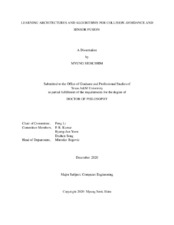| dc.description.abstract | The deep learning, which is a machine learning method based on artificial neural networks, enables cutting edge technologies such as autonomous driving, collision avoidance, activity recognition, etc. While various machine learning algorithms are proposed for these applications, these algorithms suffer from limitations in terms of multi-modal sensor fusion, feature-level importance interpretability, feature reduction and fusion architecture modeling. In this dissertation, the aforementioned problems are addressed through spiking neural networks (SNNs) and convolutional neural networks (CNNs). Spiking neural network based algorithms and convolutional neural network based architectures are proposed to incorporate interpretable sensor fusion, and robust learning algorithms for noise resiliency and high inference performance.
An SNN is an brain-inspired computing neural network which mimics brain activity more closely. Although various spike-timing-dependent plasticity (STDP) based SNNs which are unsupervised learning implementations were proposed for mobile robot collision avoidance, these algorithms only focused on simple environments and feature-fusion in the networks was not well considered. Along with the exploration of reinforcement learning implementation in SNN via additive reward-modulated STDP (A-RM-STDP), we propose a new multiplicative RM-STDP rule (M-RM-STDP) for mobile robot target tracking and collision avoidance. Furthermore, a more biologically plausible feed-forward SNN architecture including coarser grained global rewards is examined.
Sensor fusion technologies are getting attention due to their enormous potential for health care and autonomous systems. CNNs empower sensor fusion architectures with improved performance but are limited in terms of feature-importance analysis, fusion weights inconsistency, and noise resiliency. Deep multi-model sensor fusion architectures with robustness under sensor failure circumstances are proposed. The proposed fusion weight regularized gating network exceeds the baseline deep learning architectures with and without gating factors.
Furthermore, beyond the proposed gating architecture, we explore feature dimension reduction for rare failure detection by learning from high dimensional analog/mixed-signal (AMS) circuit data. Convolution layers in CNNs effectively extract principal features from input data, but results in loss of information. A reversible residual network (RevNet) is adopted in our proposed gating architecture and explored to mitigate loss of feature information in the process of dimension reduction and to improve the performance of data-driven AMS circuit rare failure detection. | en |


